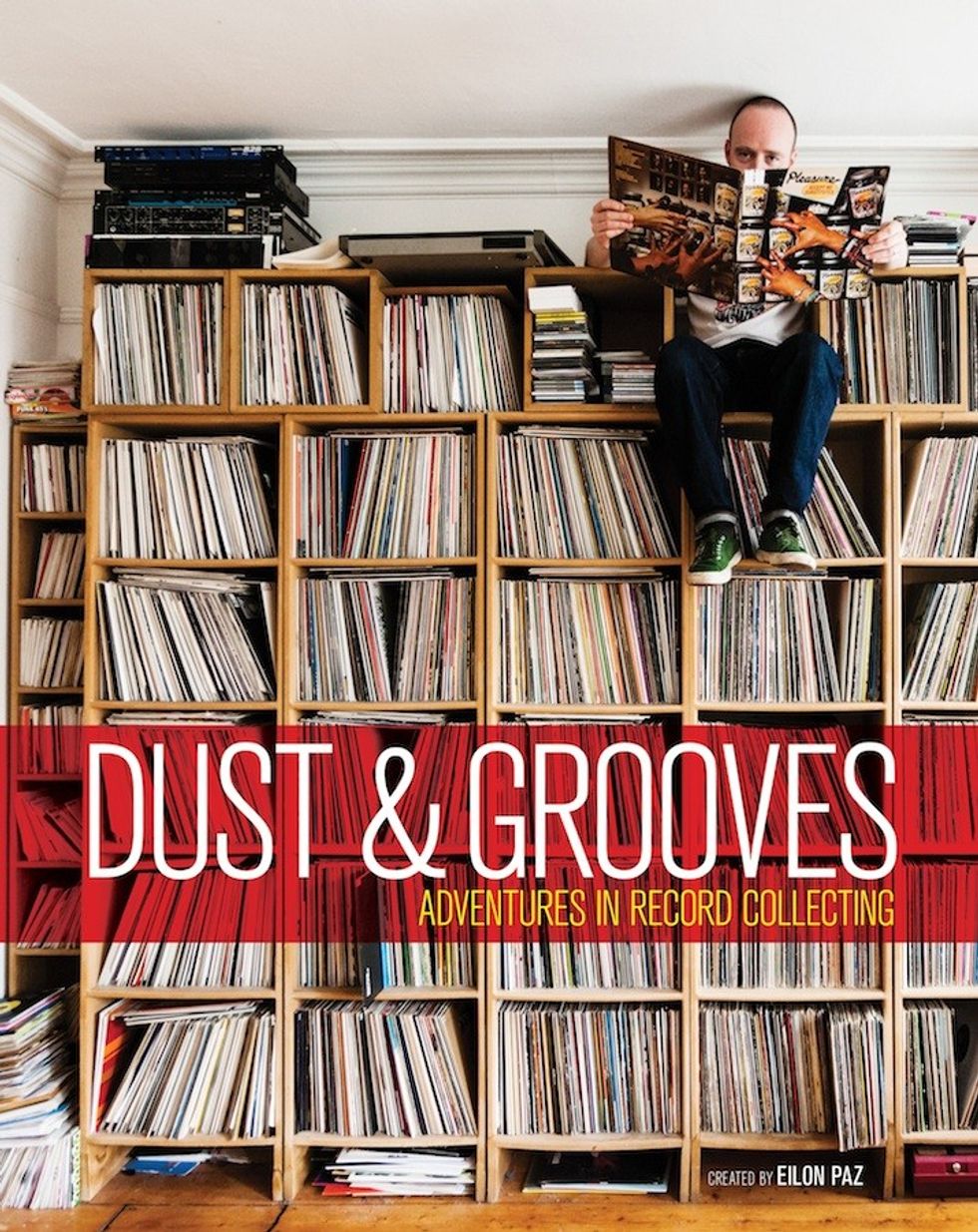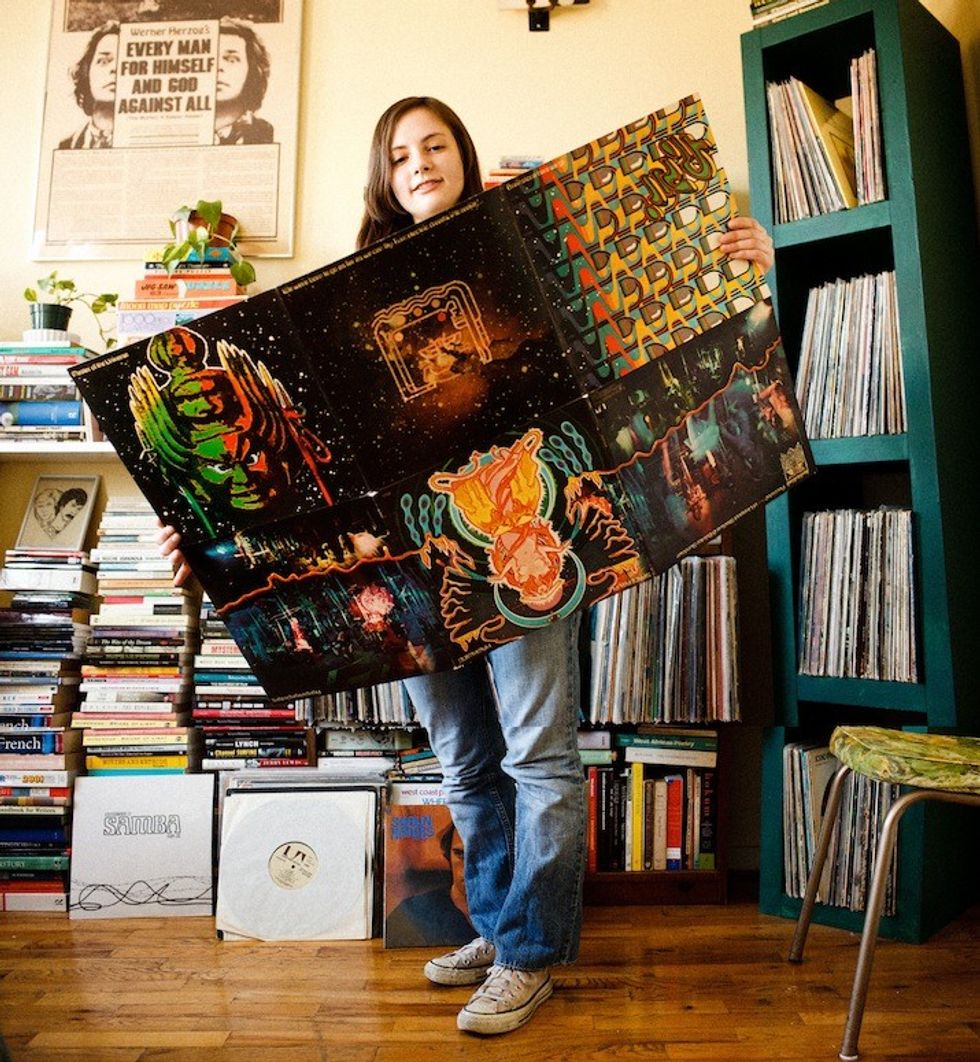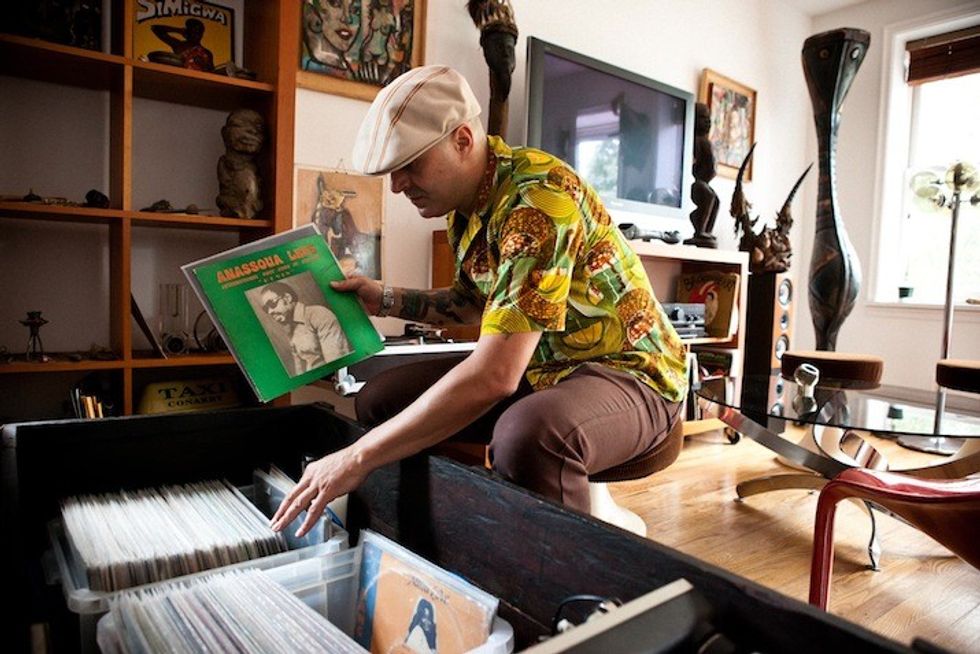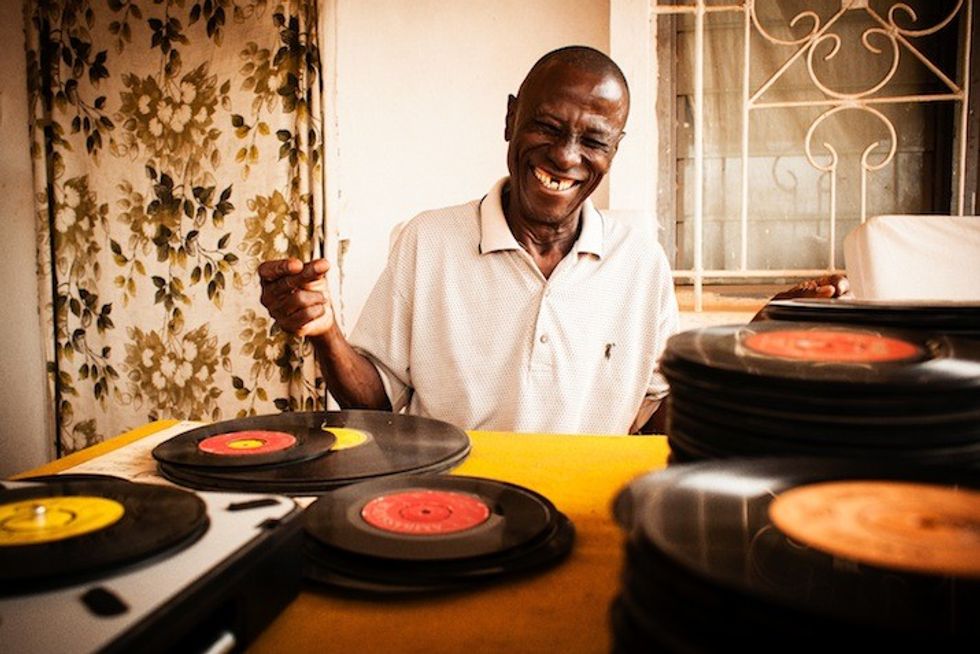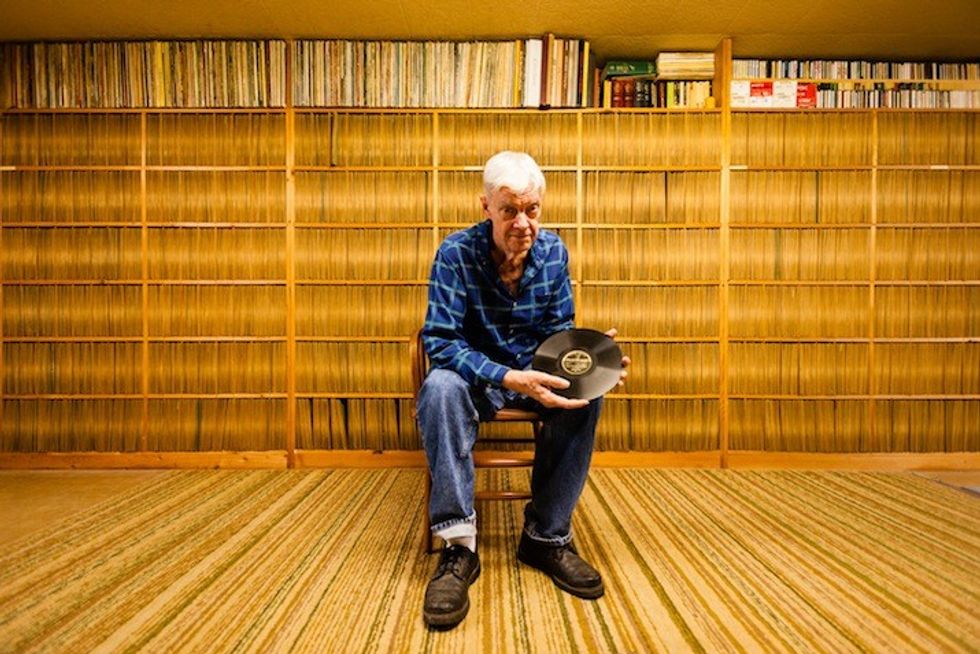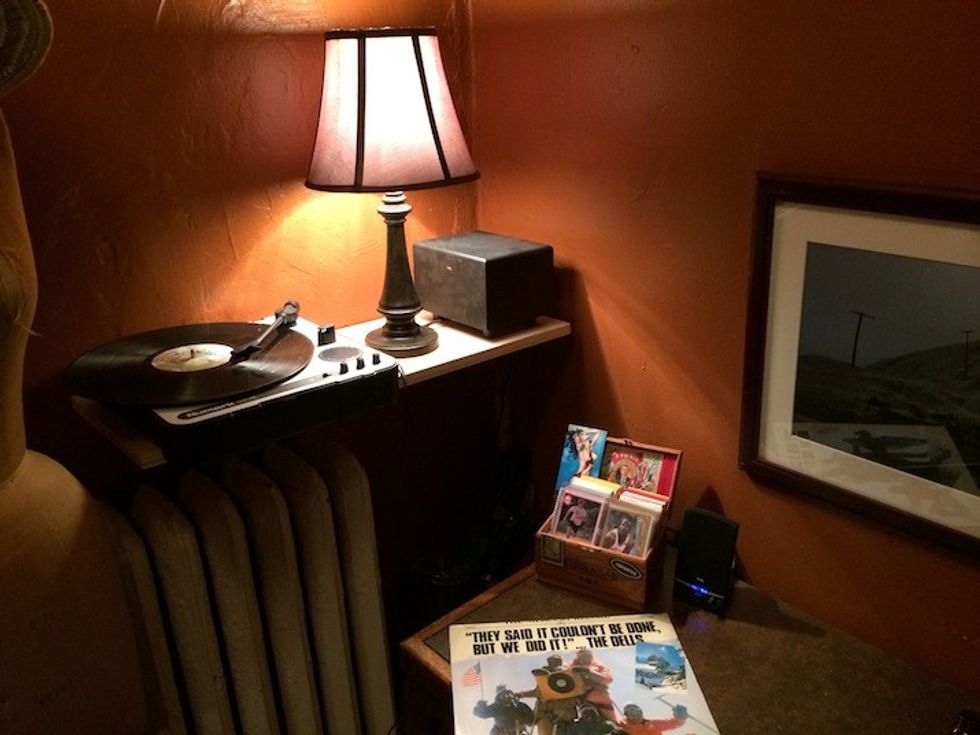Read A Book: 'Dust & Grooves' Digs Into The World's Greatest Vinyl Collections

Photos courtesy of Eilon Paz
Three and a half years ago, deep in the heart of Ghana surrounded by dirt roads and tin sheds, Eilon Paz sat calmly outside of his hotel enjoying a beer. He was there waiting for vinyl to appear. Sitting at the same table with a bottle of his own was Frank Gossner, a New York City record collector notorious for both his love of West African music and the lengths to which he'll go to get it. Gossner's home collection overflows with funk and highlife singles picked up on repeated digging trips to Africa; catch him DJing in Bangkok or Berlin and you'll be savoring the absolute rarest of grooves, hand-picked from crumbling record stands and stifling living rooms.
A seasoned vinyl ace, Gossner is something of a legend for getting great music out of Tamale and onto his turntable. But that day in 2011 was yielding nothing. "Since there's no flea market or stores, you have to just be patient," Paz remembers.
Their chosen spot was the small town of Mampong, a dot on the map that Gossner had eyed with hopes of scoring big. "In Ghana, because it's been picked over so many times, the way to find good records is to go to really remote places," Paz told me over coffee at a spot near his Brooklyn apartment. "You have to go really, really far out--to the outskirts. And this is what we did."
Paz is fascinated by vinyl, but his true calling is photography. The creator and curator of the blog Dust & Grooves, he's been chasing down the world's greatest record collectors for the better part of a decade, capturing them at home amongst their shelves of beloved 45s, 78s, and LPs. It's a project that's taken him all over the world, from airy Argentine courtyards to cramped Tokyo stacks, through Detroit dens and more than a few Brooklyn lofts.
By the time they arrived in Ghana, Paz had already photographed Gossner and his massive collection--but the African excursion held the thrill of even more dazzling imagery.
Dust & Grooves is Paz's life's work, and the results are stunning. With his masterful photography and fiery love of music, he's won over the global vinyl community; over 150 collectors, from Gossner to Mr. Scruff to Gilles Peterson, have welcomed Paz into their homes and put their libraries on display, turning the project into a living log of music and the people who have given up their lives to it. This spring saw the leap from digital to print with the release of Dust & Grooves: Adventures in Record Collecting, a gorgeous (and mighty) 416 page photo book loaded with quotes, interviews and images of some of the best record stashes on the planet.
But how to compile an entire book of vinyl collectors? What rhythm could it take, other than a flat repetition of the same cliche shot: a happy owner smiling in front their wall of records?
As he gradually built the book, Paz answered these questions by letting the vinyl scene's deep variety speak for itself. Turn the pages of Dust & Grooves and you'll catch Robert Johnson test pressings, entire shelves of horror movie soundtracks, a sizable dose of J Dilla and directions on How to Speak Hip. Owners cling to their favorites with care, pressing their fingerprints onto music that's already a part of them. There's X-rated album art, obscure German jazz labels and apartment feng shui. The book is beautiful and vast; reading it is a lesson in the wide wildness of culture that's found its way onto wax.
"There are so many aspects of vinyl--it's not just about the music," Paz said. "I would pursue a collector if I knew they had expertise in graphic design and album art. There's one guy in the book who holds the world record for most colored vinyl in the world. There's a French guy who buys only defaced cover sleeves." Pausing to reflect on all the collections he's encountered, he almost regrets that the book made him choose. "This was like one shot!" he smirked. "This is like you're DJing for God and you don't get another chance."
Dust & Grooves began in 2008. It was then that Paz packed up his camera equipment and moved from Israel to New York City with hopes of making it as a photojournalist. But despite his experience (and best of intentions) his timing couldn't have been worse. Paz landed in America just as the economy was tanking. "Everybody was frozen," he said. "Nothing, no productions. Budgets were cut down. I just found myself kind of like a tourist, walking, thinking 'What should I do?'"
What he did was go vinyl shopping. Paz hit the record shops of Manhattan and Brooklyn, slowly using up his savings while discovering just how dedicated some collectors can be. He quickly linked up with Gossner, who introduced him to store owners and crate diggers who might be open to his questions (and his camera). As those shoots accumulated, the Dust & Grooves website began to take shape, but Gossner himself kept cagey.
"Frank wouldn't let me into his house. He was supportive, but cautious." It took two more years for Paz to gain access to the African aficionado's stockpile. "He had a release coming out and he said 'Alright, this could be a good time to do a feature.' That was the first time that I went to his place, and he had just gotten a big shipment from Ghana."
Paz sat in the hotel courtyard as they day grew dingy with January heat. Mampong was beginning to feel like a bust, with no records to buy and nothing to photograph. Despite Gossner's best efforts to put out the call for music, pinning up flyers and buying time on local radio stations, those with good vinyl were missing the memo. "He spent a lot of time and money just waiting for the records to arrive," Paz remembered. "Because basically it's like intelligence work. You go there and there are no record stores."
Reconsider this image: two white New Yorkers buying vinyl from local Africans with plans to export it, play it at lucrative DJ sets and then literally mount it on the wall back home. If the scene makes you uneasy, you're not alone. I pressed Paz about the precedent of Western "explorers" carting off African resources and he admits that, for some, Gossner's work could seem malicious. "It really depends on your perspective."
Paz turned the questions around and back at me. "What is the Ghanaian record scene? Is there a Ghanaian record scene?" There isn't one, he stresses. The local vinyl of Ghana isn't counted as precious or special--it's just another thing. A good to be bartered, bought and sold. Africa's visiting diggers are driven by pleasure and prestige, but their work is also a kind of rescue operation. Much of what gets found and taken also gets reissued, and Gossner strives just as hard to put new high-grade pressings and royalty money into the hands of the Africans whose songs he's re-released abroad. The music that was warping under the sun and eroding upon the sand gets a new lease on life. "It's beyond preservation," Paz said. "It's actually saving music."
Still, there's no debating where most of the money flows. "Frank's honest about it," Paz said of Gossner. "He wants to own this music, put it out there, and be able to make some money off it." The record collecting world is full of these kinds of knotted-up transactions. It's not a simple or easy thing to talk about. "It's really up to your own eyes. Some new African music conservation groups have started to pop up, and I think we have Frank to thank for it."
Paz is sure of where he stands, and his last point is indisputable. "The music needs to be heard. It should be brought to the masses."
As the days passed a few people did bring in crates for the two to dig through, but nothing interested Gossner, who would listen on his portable turntable for only a few seconds before lifting the needle and turning them down. Paz remembers the anxiety of those empty hours. When vinyl hunting is your life, silence is a special kind of agony.
That was when Phillip appeared.
Phillip Osei Kojo, a 90 year-old Mampong local, had heard that Paz and Gossner were looking for records and invited them to bring their turntable to his house. Just a short trek from the hotel, the place was piled with messy stacks of funk, afrobeat, and highlife vinyl. Gossner's eyes went wide and he set to work digging, sorting and listening--only to sigh and shake his head once more. Phillip's home stash was impressive, but none of it would be going home with Gossner.
And yet, as the needle dropped on each dusty record, Paz kept snapping photos. From behind the lens, he had noticed a change in their host. "You couldn't really understand Phillip's emotion, his reaction, but he had this amazing look on his face." Later they learned that it was a look of awe. Phillip's home turntable had broken down decades ago; he hadn't listened to his own music in over 30 years.
The next day Paz took the turntable and went back to see Phillip. "I spent like two hours with him just listening to his records. It was amazing. Just having fun, taking photos--he was totally emotional about it." The proof is in the pages of Dust & Grooves itself. Full-page shots of Phillip, holding his vinyl and listening with joy, figure prominently in the book. If anyone has doubts in the power that music holds, these photographs stand as shimmering new proof.
A year after returning home from Ghana, Paz bought a new turntable and had it shipped direct to Phillip. Leaning back from our cafe table, his tale all told, Paz looked off to think for a beat. When he met my gaze again, he was beaming. "It was totally different. It meant something beyond our selfish projects."
Dust & Grooves has turned Eilon Paz into a collector of record collectors, an archivist of people that don't just love music but are living with it in the most physical way. And while he's too humble to admit it, the project has made him a vinyl authority. He talks confidently about old Turkish psych-rock ("a crazy hot commodity") and how crate digging will never be the same after eBay. Record collectors, with their insatiable and active approach to art, are his kind of people. He and I agreed that they're more athletic in their listening. Playing vinyl is a manual kind of thing--flipping sides, changing records and pulling out the albums that should come next. "What unifies them is an attention to detail," he said. "That, and they also don't move around much. Having a collection is a pain in the ass."
But the extra work--the "pain in the ass"--is also the payoff. "It's not an easy way to interact with music," Paz admits. "It's very rewarding, though. It demands your attention and when you listen, you interact with it."
His favorite question to put to collectors is "What's your comfort record?" Paz explains: "It could be anything. It doesn't have to soothe you, it could be the stuff that makes you want to jump and dance. A comfort record is probably that 'question music' that pulls out emotional answers." It usually takes a while for that one record to get pulled out, but when it does Paz can see his subject change. "It's a spiritual thing, something that brings you closer to a spiritual experience. It's oftentimes John Coltrane, Joni Mitchell or Curtis Mayfield."
The print edition of Dust & Grooves is more than just pixels and paragraphs--it gives readers a portrait of the vinyl community as it seeks, shelves and spins the best music on earth. The book's first edition was released this spring and is almost entirely sold out (a few deluxe copies of the book, signed and numbered by Paz himself, are still up for grabs). The second edition, though, is coming in September and will feature an interview with Paz's own "holy grail" collector, Okayplayer CEO Questlove himself.
Readers who have never bought a record will get inspired to start digging. Seasoned collectors will feel a push to continue. And anyone who's retired--"cashed out"--will itch to get back in the game. The book is like a great record in that the more time you give it, the more you learn and the better you become. Paz's work holds so much music--it almost has a sound.
Before we parted ways, I asked him about his goal. Why all the work? I had to know what Paz really hoped to get out of Dust & Grooves. He met my question with another smile, reaching for his phone to show me a text from a friend who had just finished the book: "Got inspired and set my record player back up." It was all the answering that either of us needed.
>>>Pre-order copies of Dust & Grooves (2nd edition) here
>>>Buy a hand-signed 1st edition copy here
>>>Visit Dust & Grooves for more

